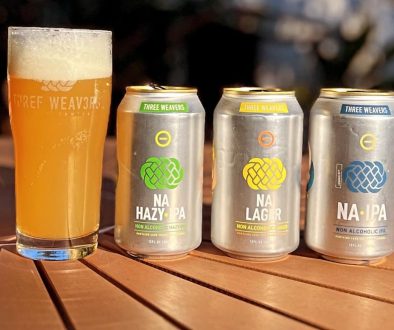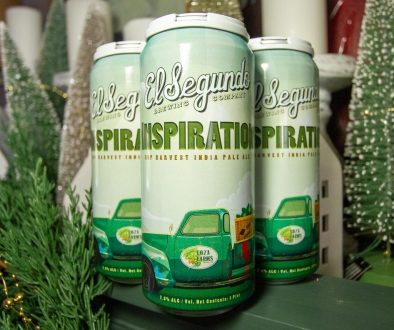Brewers and Drinkers Both Win When Craft Beer Gets Canned
Remember when canned craft beer wasn’t cool? When microbrew drinkers looked down their nose at Oskar Blues and you often heard the “good beer doesn’t come in cans” line? In the fast growing craft beer industry it can be easy to forget that stocking the ice chest before a camping trip or day on the boat meant compromising on the few brews that you could find offered in cans. In today’s craft beer marketplace cans are undeniably hot, and they’re growing more common every day as new producers turn to cans instead of bottling their products, and established craft brands add canning capabilities to their facilities.

Lagunitas is one of the latest major craft breweries to join the canning trend, and the 12th of Never Ale — their new year-round, nationally distributed brand — is flooding into the marketplace. These 12-packs of loud purple cans mark a sudden and striking end to the brewery’s long-held claim that they’d be the last craft brewery to commission a canning line. (They were close — of the Brewers Association’s Top 50 U.S. Craft Breweries ranking only Deschutes Brewery outlasted Lagunitas among the top 10 breweries.) Other hold-outs among the top echelon of craft beer producers that have recently turned to the fan-favorite packaging are Stone Brewing, Victory Brewing, and reportedly Dogfish Head. What is driving all of these bottling brewers to finally embrace the hottest trend in craft beer packaging since the waxed bomber?
The easy answer, and the one that is most often offered by the brewery spokespeople, is simply consumer demand. Craft beer drinkers love canned brews, and for good reason. Cans are convenient, packable, and great for beer. They are light-proof and less vulnerable to oxygen ingress than capped bottles (believe it or not, bottle caps are not 100% air-tight). The environmental benefits of aluminum cans are less clear, but they are largely a more friendly package as it is easier and cheaper to recycle as well as being much lighter which decreases the carbon impact of shipping. However, they are not without their environmental downside, and the damaging process required to mine aluminum was cited by Lagunitas founder Tony Magee as a primary reason for avoiding the canning craze at first. Magee’s concerns over bauxite mining were hedged against consumer demand in 2013, and it didn’t even take the anticipated five years for Lagunitas to fill space set aside in their Chicago brewery for a canning line.
But the biggest craft breweries aren’t just signing off on massive capital outlays for canning equipment because customers want to drink craft beer in cans — these businesses see other benefits to the substantial costs. It largely comes down to distribution and retail placements.
The craft beer industry is a unique collection of disparate businesses with wildly different business models. What drives decisions at the popular local breweries who maybe push 10,000 barrels of beer into the market each year is nearly unrecognizable to the giants of the industry like Lagunitas and Stone. Where small, independent brewers can, as El Segundo Brewing founder Rob Croxall says, “make a pretty good living just selling beer over the bar at their tasting room,” the big players need to succeed in the retail market. Not just the bottle shops and specialty retailers, but the big-box stores, grocery chains and convenience stores — the same spots where the macro beer brands have been fighting over, and entrenching themselves in, for decades.
These beer battlegrounds are cutthroat and tactics are focused on winning over real estate inch-by-inch of shelf space. One of the weapons developed by the macro brands is SKU proliferation — where a half-dozen different packaging configurations are stocked for the same brand. Six packs of Bud Light next to 12 packs, and 30-racks, and tall boys and six packs of 16-ounce cans, etc etc. Adding canned offerings of flagship brands is one way that craft breweries can fight for more shelf space and “share of mind” in beer distributor speak.
Lagunitas is taking a slightly different approach with 12th of Never as it is only available in 12-packs of 12-ounce cans, a format tailor-made for retail placements in the aforementioned big box, grocery and convenience stores. The brand will also be available in all 50 states, and all production of canned 12th of Never will occur at the Chicago brewery. That’s a lot of beer originating in Chicago and being trucked to every corner of the country, which highlights another business advantage of canned beer: it’s easier to ship. More cans can fit on a pallet, pallets weigh less, and breakage and loss is lower for canned product. It all adds up to beer that costs less to get from the brewery to the market — 21st Amendment Brewery founder Sean O’Sullivan told the East Bay Express that the brewery can ship 110 cases of canned beer for the same cost as 70 cases of bottled beer. That’s significant savings, especially at the scale Lagunitas operates at. Stone Brewing’s new Berlin brewery will package beer only in cans and in kegs — a decision likely driven at least in part by this saving in shipping costs as the Berlin brewery will be supplying all of Europe with Stone’s brews.
Canning beer is not just for the biggest, most ambitious, or most daring craft brewers anymore, and with the popularity of on-demand canning solutions like the Beer Monks in Los Angeles and the Can Van in the Bay Area, canned beer is hitting the market from breweries of every size. The proliferation of canned craft beer is a rare example of consumer demands aligning with business-driven decisions, and the trend shows no sign of slowing down.



